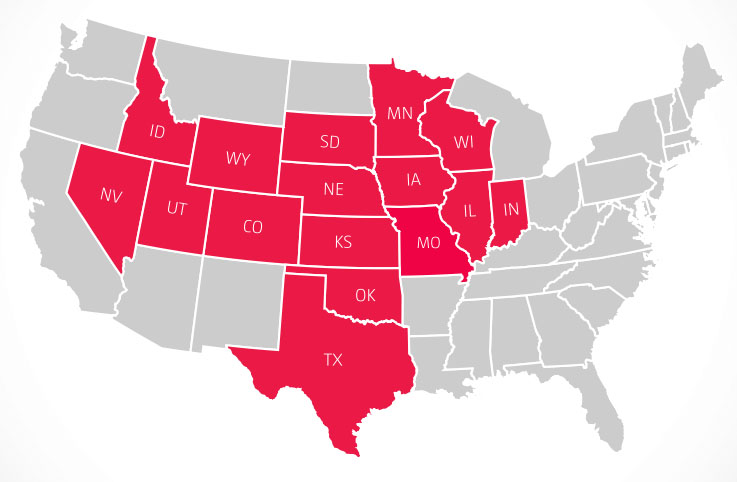Here’s a quick overview of the most widely available internet providers: By comparison, your other widely available satellite internet provider, HughesNet, offers 25 Mbps download speeds and only 15–100 GB of data. One thing: Don’t expect those 100+ Mbps speeds in truly remote areas. Pricing for EarthLink Wireless Home Internet
$49.95 to $149.95 a month10, 15, 30, 60, 80, 100, 300, 500, 1,000, 2000, and 5000 GB per month plans4G LTE or 5G speedsRouter fee: $12.95/mo. Activation fee: $79.95
Learn More at EarthLink If you live in Texas, Colorado, Idaho, and Illinois—we think Rise Broadband is worth a serious look. Two things to note about Kinetic by Windstream prices, though: they change based on where you live, and they go up after your first year. (But that kind of promotional pricing is normal when it comes to internet land.) Here’s a quick peek at some of Kinetic by Windstream’s pricing: While the ISP says it no longer offers DSL internet, it does still offer internet in rural areas. If your home is pretty far off the beaten path, you could see speeds as slow as 768 Kbps—that’s less than 1 Mbps. Another option may be a mobile Wi-Fi hotspot—or if you’re trundling across the country in your RV, there are other portable satellite internet options too. And if worse comes to worse, dial-up internet still exists. (And it’s free.) If you keep an open mind, there’s likely a way to get connected even if you’re off the beaten path.
Not all internet connections are equal—our first choice is cable and fiber but for rural areas, fiber may be harder to find. Then DSL (VDSL or VDSL2), then satellite, then fixed wireless, then mobile Wi-Fi hotspots, and last, dial-up. You may not get unlimited data or even 1 TB of data, so watch your data cap. Your download speeds and upload speeds may be too slow for streaming Netflix, video calls, or gaming. (Check out our best internet picks for gaming if you want to learn more.) Speaking of gaming, if you go with satellite internet, your latency may be too high to play first-person shooters (FPS) and other action-oriented games. Also, keep in mind that a Wi-Fi connection may not give you enough speed compared to a wired connection.
For example, my folks live in a rural part of Northern Georgia and get their internet from a local electric co-op. The price is much lower than satellite internet, and for the most part, the service holds up well. Cable internet: Cable is our first choice for the fastest speeds and (usually) the most data at a low price. But it’s not available in a lot of remote areas, and if it is available in your area, you might pay more for it than your city slicker neighbors. Fiber internet: Fiber-optic internet offers some of the fastest speeds and is one of the most reliable internet options. Unfortunately, it isn’t as widely available as cable, DSL, or satellite may be. Luckily, most ISPs like Kinetic by Windstream are actively working on building out the infrastructure needed to bring this option to more rural towns. If it’s not available where you live right now, fiber-optic internet may be an option in the future. DSL internet: DSL may be older and slower than cable, but it’s still a solid choice thanks to lower prices and potentially higher data caps when compared to satellite internet. DSL also tends to be more widely available in rural areas, but be warned: many providers are phasing out their DSL internet service. Satellite internet: Although it’s not our first choice thanks to its high prices and low data caps, satellite internet reaches more rural and remote areas than any other type of internet connection. So if satellite is your only option, rest assured it’s still a great internet option for the country. Fixed wireless: Fixed wireless is a newer technology that’s still ramping up its availability. Even so, its prices tend to be a lot lower than what satellite internet providers charge, and some fixed wireless providers even offer unlimited data. We also tried to cover several different connection types in order to showcase a more expansive list of choices, and also made a point to recommend local providers since those may be more capable of handling local internet needs in rural areas. One notable omission is Starlink satellite internet. While Starlink is growing its availability as it launches more satellites, it may not be available in all areas. Additionally, the service is still relatively new and so we can’t definitively comment on whether it’s worth the price or not. But the best internet for anyone living in a rural area really depends on what’s available to you and where exactly you live. Likely you’ll have the option of satellite internet—but fixed wireless, DSL, and mobile internet tend to be cheaper and may offer more data and faster speeds. It mostly comes down to cost. Because rural areas are home to fewer people, there are fewer households that will purchase internet service. That means there’s less money to offset the cost of building out or upgrading an internet network. That’s a pretty short answer to something we could chat about for days. We’ve seen a lot of change in the internet and telecommunications industry that could see more and better rural internet options headed our way. That includes the Federal Communications Commission’s (FCC’s) Rural Digital Opportunity Fund (even though it has its drawbacks) and the growth of municipal internet providers across the country. And keep in mind that while Netflix recommends a max speed of 25 Mbps, that’s a dedicated speed of 25 Mbps. So you likely won’t be able to stream Netflix in 4K while using any other connected devices. We go into more detail on this very topic in our best internet for streaming and internet speed guides. The type of 5G typically used in big cities (mmWave) has a short range and trouble penetrating objects like—you guessed it—trees, hills, and mountains. Still, rural communities should see low-band 5G technology soon, which still offers an upgrade to older technology like DSL even though it’s not as speedy as mmWave 5G.













